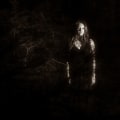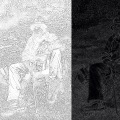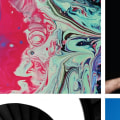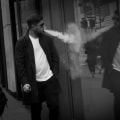Night photography can be a challenging but rewarding experience. Capturing the beauty of the night sky, stars, and the cityscape requires a unique approach to photography. One of the most popular techniques used for night photography is light painting. Light painting is a technique that uses long exposure time to capture light sources and create interesting images.
This technique can be used to capture stunning landscapes, cityscapes, and even abstract art. In this article, we will discuss the basics of light painting and how it can be used to create amazing night photographs.
Getting Started with Light Painting
Light painting photography can seem like a daunting technique to learn, but with the right equipment and a few simple steps, you can easily get started. The first step is to choose a good location. This should be somewhere dark and away from light pollution.You'll also want to choose a spot that has interesting elements that you can use in your light painting. Once you've chosen your location, the next step is to set up your equipment. You'll need a tripod, a camera, and a light source of some kind. If you're using an LED light, it's best to get one with a dimmer switch so you can control the brightness.
Once your equipment is set up, it's time to take your shot. The key to successful light painting is timing. Start by setting your shutter speed to the longest possible. This will help capture the most light possible.
Next, use the timer on your camera and set it for 10-15 seconds. This will give you enough time to paint with light while the shutter remains open. Now it's time to start painting with light! Use your light source to draw shapes or write words in the air. Make sure you move your light slowly and steadily so you don't blur the image. You can also experiment with different colors of lights and create interesting patterns.
Once you've finished painting with light, take your shot! You may need to take multiple shots in order to get the desired effect. Don't forget to review your images and make any adjustments if necessary. By following these simple steps, you can easily get started with light painting photography. With practice and patience, you can create stunning images that capture the beauty of the night sky.
Post-Processing Light Paintings
Post-Processing is an important step for any type of photography, but it is especially important for light painting as it can help to enhance the images and make them more beautiful.By using post-processing, you can adjust the brightness, contrast, and color balance of your photos to make them look more natural and professional. Additionally, you can also apply various filters and effects to add more drama and creativity to the image. The first step in post-processing a light painting image is to adjust the exposure and white balance. This will help to ensure that the colors are accurate and that the image is properly exposed.
You can also use curves or levels to adjust the brightness and contrast of the image. Additionally, you can use selective color adjustments to bring out certain tones and hues in the image. Once you have adjusted the exposure and contrast of your image, you can begin to add various filters and effects. For example, you can add a vignette to draw attention to certain areas of the image or apply a grainy filter to give it a vintage look.
You can also apply various textures or color gradients to add depth and interest to your photo. Finally, you can use tools such as Dodge & Burn or Clone Stamp to make local adjustments to specific parts of the image. By taking advantage of post-processing techniques, you can enhance your light painting images and make them look more professional. With practice, you will be able to produce amazing results with minimal effort.
Getting Creative with Light Painting
Light painting photography is a great way to get creative and capture amazing night scenes. The technique involves using a light source to “paint” an image on the camera’s sensor.It can be used to create stunning images in both regular and low light conditions. To get creative with light painting photography, it helps to understand the basics of how it works. The light source is used to draw patterns or shapes in the air, which the camera then records as part of the image. You can use a flashlight, LED light, or sparkler to create the desired effect.
When you’re ready to start light painting, you should consider the environment and the type of light you’ll be using. For example, if you’re shooting in a dark area you’ll want to use a bright light source that will be visible in the scene. On the other hand, if you’re shooting in a more lit area, you’ll want to use a dimmer light source to create a more subtle effect. Once you’ve chosen your light source, it’s time to get creative! You can use different techniques to create different effects in your images.
For example, you can move your light source in circles or lines across the scene to create patterns and shapes. You can also move your light source quickly or slowly, depending on the desired effect. You can also experiment with different colors of light to create unique images. If you have multiple lights, you can even combine them to create interesting effects.
Finally, don’t forget to experiment with shutter speed when light painting. By changing the shutter speed, you can control how long the light is exposed and create different effects in your images.
The Basics of Light Painting
Light painting is a creative technique used by photographers to create stunning night scenes. It involves painting with light during a long-exposure photograph, often with a handheld light source like a flashlight. By combining the movement of the light source with the light-sensitive nature of the camera, photographers can create unique images in both regular and low light conditions.The key to successful light painting is to experiment and be creative. You can use different colors, shapes, and sizes of light sources to create interesting patterns and shapes in your images. To achieve this, you'll need to move the light source while the camera's shutter is open, either manually or by using a motorized device like a rotator or jib arm. This can be done in one continuous motion or in small intervals, depending on the desired effect.
You can also combine multiple light sources and experiment with different exposure times for even more creative results. You'll also need to consider how the light interacts with the elements of your scene. For example, if you're shooting a landscape, you may want to make sure that the light source doesn't overexpose the sky or other bright areas. You can use gels and other filters to control the light intensity and color of your light source, as well as modify its shape. Light painting is a great way to add an extra level of creativity to your photography, and it's relatively easy to get started. All you need is a camera that has manual settings, a tripod, and a light source like a flashlight.
Once you have those basics down, you can start experimenting with different techniques and equipment to create unique images.
Troubleshooting Light Painting
Light painting photography can be a tricky art to master, and it's easy to make mistakes. Some common mistakes photographers make when trying to capture light painting photographs include:Using the wrong shutter speed:Using too long of a shutter speed can result in blurry photos and too short of a shutter speed will not capture the light trails. Experimenting with different shutter speeds can help you find the right balance.Not using a low ISO setting:
Using a low ISO setting will help reduce digital noise in your photos, which is especially important when shooting in low light conditions.Not using a tripod:
Using a tripod can help keep your camera steady and reduce blurriness in your photos. It also makes it easier to line up the camera with the desired composition.Not bringing extra batteries or flashlights:
Bringing extra batteries and flashlights can help ensure that you have enough light for your light painting photo shoot.Additionally, having extra batteries will allow you to take multiple shots if necessary. Light painting is an incredibly effective way to capture stunning night scenes. It's a great way to explore your creativity and take your photography to the next level. With the right equipment, techniques, and post-processing skills, you can create beautiful images with light painting. Use the tips outlined in this article to get started with light painting today!.








